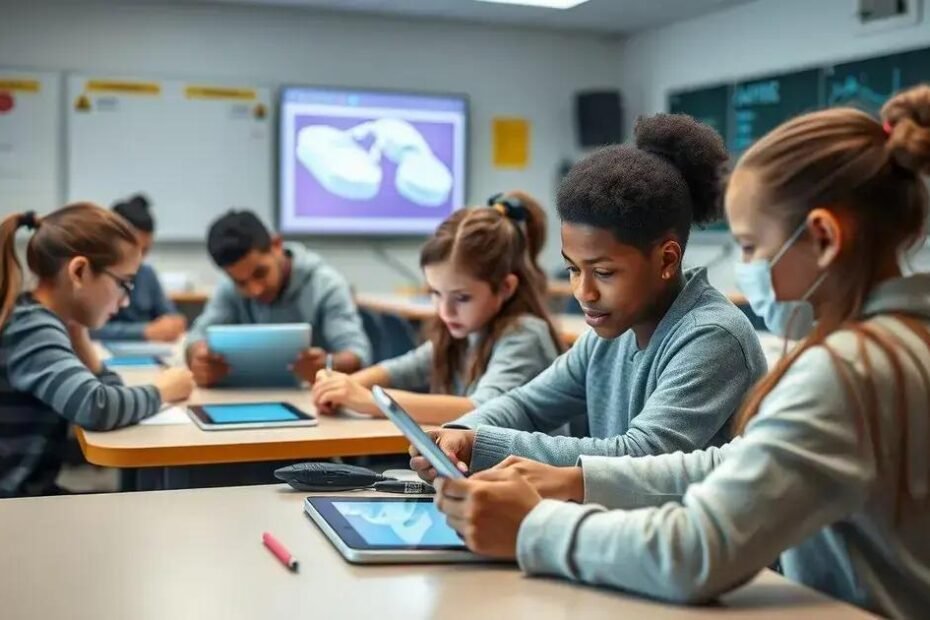AI integration in education enhances personalized learning experiences, automates administrative tasks, and offers innovative tools, but it also faces challenges like resistance to change and data privacy concerns.
AI integration in education holds the potential to change how we learn and teach. Have you ever wondered how technology can enhance student engagement and make learning more personalized? In this article, we’ll delve into its impact on today’s classrooms.
understanding AI in education
Understanding AI in education is essential for grasping how technology is reshaping today’s learning environments. Schools and educators are increasingly adopting AI to enhance the teaching and learning experiences.
How AI is Changing Education
AI systems analyze data to offer personalized learning pathways for students. This technology enables teachers to tailor educational content according to individual needs, making learning more effective.
For instance, AI can identify a student’s strengths and weaknesses, allowing teachers to focus on areas where improvement is needed. With AI, students receive instant feedback on their performance, which helps them progress more efficiently.
Key Features of AI in Education
- Personalized learning experiences
- Automated administrative tasks
- Data-driven insights for teachers
- Enhanced engagement through interactive tools
Moreover, as educational methods evolve, AI also supports teachers by reducing their administrative burden. Tasks that previously took hours can now be done in minutes, allowing educators to focus more on teaching.
The integration of AI-driven tools, such as adaptive learning platforms and chatbots, fosters a more engaging classroom atmosphere. These tools not only make lessons more enjoyable but also help students retain information better.
benefits of AI in the classroom
The benefits of AI in the classroom are transforming how students learn and teachers instruct. Implementing AI technology can lead to remarkable improvements in educational outcomes.
Personalized Learning Experience
One significant benefit is the ability to offer personalized learning experiences. AI systems analyze student performance and adapt lessons to suit individual needs. This means that students can learn at their own pace, enhancing understanding and retention.
Efficiency in Administrative Tasks
Another key advantage is increased efficiency. AI can automate repetitive administrative tasks such as grading tests and managing lesson plans. As a result, teachers can devote more time to classroom interaction and innovative teaching methods.
- Reduced grading time
- Streamlined communication with students
- More time for lesson planning
- Improved classroom management
With AI, teachers also gain access to insightful data analytics. This data helps them understand classroom dynamics better, allowing for adjustments that enhance student engagement.
Furthermore, AI tools can offer interactive and engaging learning methods. By integrating gamification and adaptive learning, students become more involved in their education. These methods not only make learning fun but also help in reinforcing concepts in a memorable way.
challenges of integrating AI

Integrating AI into the classroom brings numerous benefits, but it also presents significant challenges that educators must address. Understanding these challenges is crucial for successful implementation.
Resistance to Change
One main challenge is the resistance to change from both teachers and students. Many educators may feel overwhelmed by new technology, fearing it will replace their role. Students might also be hesitant to use AI tools, preferring traditional learning methods.
Data Privacy Concerns
Another pressing issue is data privacy. With AI systems collecting vast amounts of data, schools must ensure that students’ personal information is protected. There is a risk of unauthorized access or misuse of sensitive data.
- Understanding data security risks
- Establishing clear privacy policies
- Training staff on data protection
- Gaining parental trust and support
Additionally, many schools face financial constraints that limit their ability to invest in AI technology. Budget restrictions can impede the acquisition of necessary tools and training required for effective implementation.
Moreover, ensuring equitable access to AI resources is essential. Students from underprivileged backgrounds may not have the same access to technology as their peers, leading to disparities in learning experiences. Addressing this issue requires thoughtful planning and resource allocation.
practical examples of AI tools
There are many practical examples of AI tools in education that showcase how technology enhances learning. These tools help both teachers and students achieve greater success in the classroom.
Adaptive Learning Platforms
One standout example is adaptive learning platforms. These systems tailor educational content to fit each student’s individual learning pace. By analyzing student data, these platforms recommend specific resources and exercises to boost understanding.
AI Tutoring Systems
Another effective tool is AI tutoring systems, which provide personalized assistance to students outside of the classroom. These virtual tutors can answer questions, offer explanations, and guide students through complex topics.
- Examples include:
- Khan Academy’s personalized learning paths
- Duolingo for language learning
- Woot Math for math practice
Moreover, AI-powered assessment tools streamline grading and provide immediate feedback to students. These tools speed up the assessment process and help educators identify areas where students struggle.
Additionally, many classrooms are now using AI-assisted chatbots. These chatbots can answer common questions from students, freeing up the teacher’s time for more personalized instruction. They can also facilitate communication between students and parents.
the future of AI in education
The future of AI in education holds incredible promise, as advancements in technology continue to evolve. Educators and students alike can expect even more innovative solutions that enhance learning experiences.
Enhanced Personalization
In the coming years, personalization will reach new heights. AI systems will become increasingly sophisticated, allowing them to tailor learning experiences even more closely to individual needs. This means students could receive customized lessons and resources based on their unique learning styles and preferences.
Integration with Virtual Reality
Another exciting development is the integration of AI with virtual reality (VR). Imagine students exploring historical events or scientific concepts through immersive VR experiences, guided by AI tutors. This blend of technology could create engaging and effective learning environments.
- Potential benefits include:
- Improved retention of information
- Greater engagement in lessons
- Opportunities for experiential learning
- Access to diverse global cultures
Moreover, AI will likely play a crucial role in administrative tasks. Schools could automate processes such as enrollment and resource allocation, which would free up educators to focus on teaching. Additionally, AI analytics may help educators gain insights into student performance and classroom dynamics.
As AI technologies continue to unfold, educators will need to adapt training programs and curricula to incorporate these tools meaningfully. Ongoing professional development will be key to ensuring teachers can leverage AI’s full potential in their classrooms.
The integration of AI in education presents exciting opportunities for the future. It enhances learning experiences by personalizing education, making it more engaging and effective. As AI tools and technologies continue to develop, schools need to embrace these changes to equip students with necessary skills. While challenges such as resistance, data privacy, and budget concerns exist, the benefits outweigh the drawbacks. By staying informed and adapting, educators can create a brighter future for learning.
FAQ – Frequently Asked Questions about AI in Education
How does AI personalize learning for students?
AI analyzes student data to tailor lessons and resources, ensuring each student receives education suited to their unique needs.
What are some examples of AI tools in the classroom?
Examples include adaptive learning platforms, AI tutoring systems, and interactive assessment tools that enhance the learning experience.
What challenges do schools face when integrating AI?
Challenges include resistance to change, data privacy concerns, budget constraints, and ensuring equitable access to technology.
What does the future hold for AI in education?
The future includes more personalized learning experiences, integration with virtual reality, and improved administrative efficiency through AI technologies.

